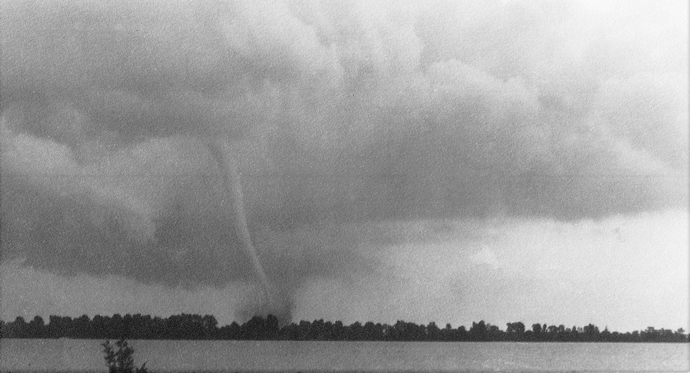Location
Essex, Ontario, Canada
Event Website
https://www.youtube.com/watch?v=R9Ca6E8DXSs
Start Date
17-6-1946 7:10 PM
Document Type
Report (PDF/Word)
F-Scale Rating
F4
Classification
Confirmed
Description
The third deadliest tornado in Canadian history, and the most deadly ever recorded in Ontario.
Violent tornado originated in the Melvindale suburb of Detroit, Michigan, and tracked ENE into Canada, arriving at Brighton Beach. It then began its extremely destructive 20km track across the Windsor area before lifting off at Belle River on Lake St. Clair. Sometimes referred to as the “Windsor-Tecumseh Tornado”
Objects lofted high into the storm by the tornado were found great distances from their origins.
An airplane was picked up by the tornado in Detroit and landed on a house in Windsor, killing the residents inside. – from “Disasters of Ontario, 75 Stories of Courage and Chaos”, (René Biberstien)
Investigated by EC as a candidate for F5 rating upgrade. It was not warranted due to lack of evidence.
“In the surrounding countryside downpours covered roads to a depth of nearly 3 feet. Floods inundated 60-70,000 acres of agricultural lands as dykes at Erieau gave way causing $5 million damage to tomatoes, corn, potatoes, beets, and onion crops. The loss considered to be a tremendous set-back to farmers striving to produce more food for post war Europe. A pair of trousers found between Belle River and No. 2 HWY by Mrs. Walter Dourocher in her garden. In the pockets were telegrams and other identification that proved the pants to Waldo Beeman who along with his 19 year old bride and their baby were killed by the tornado.
Ray Milner, pilot of an incoming aircraft described the advancing tornado. “It was ripping through power lines and the ground was covered with blue flashes like the pictures of bombs bursting. I could see from my pilots seat in the plane how it crumpled buildings like eggshells. It would pick up other objects and whirl them around.””
New Track Map Windsor 1946.jpg (16866 kB)
June 17, 1946 Windsor, Essex Map.jpg (7827 kB)
june-17-1946-a-tornado-rips-through-the-windsor-area-on-ju1.jpg (40 kB)
Globe and Mail June 1946 Windsor tornado.pdf (20905 kB)
June 17, 1946 Windsor (Photos of tornado contact sheet).pdf (6771 kB)
June 17, 1946 Windsor (Photos of tornado).pdf (7943 kB)
June 17, 1946 Windsor Photo Folder.pdf (53666 kB)
Windsor Star June 18-29, 1946.pdf (137547 kB)
Hamilton Spectator 1946 Windsor tornado.pdf (3423 kB)
June 17, 1946 Deaths and Injuries.pdf (17841 kB)
June 17, 1946 Distribution of Debris.pdf (10614 kB)
June 17, 1946 Tornado Anecdotes Folder.pdf (24921 kB)
June 17, 1946 Windsor Newspaper Photos Folder.pdf (44178 kB)
June 17, 1946 Work of God Folder.pdf (2438 kB)
London Free Press 1946 Windsor tornado.pdf (40983 kB)
Toronto Star Windsor tornado 1946.pdf (10507 kB)
Toronto Telegram June 1946 Windsor Tornado.pdf (11135 kB)
Windsor Library Scrapbook.pdf (67176 kB)
Windsor Tornado June 17, 1946 (news and info folder).pdf (21655 kB)
Windsor
Essex, Ontario, Canada
The third deadliest tornado in Canadian history, and the most deadly ever recorded in Ontario.
Violent tornado originated in the Melvindale suburb of Detroit, Michigan, and tracked ENE into Canada, arriving at Brighton Beach. It then began its extremely destructive 20km track across the Windsor area before lifting off at Belle River on Lake St. Clair. Sometimes referred to as the “Windsor-Tecumseh Tornado”
Objects lofted high into the storm by the tornado were found great distances from their origins.
An airplane was picked up by the tornado in Detroit and landed on a house in Windsor, killing the residents inside. – from “Disasters of Ontario, 75 Stories of Courage and Chaos”, (René Biberstien)
Investigated by EC as a candidate for F5 rating upgrade. It was not warranted due to lack of evidence.
“In the surrounding countryside downpours covered roads to a depth of nearly 3 feet. Floods inundated 60-70,000 acres of agricultural lands as dykes at Erieau gave way causing $5 million damage to tomatoes, corn, potatoes, beets, and onion crops. The loss considered to be a tremendous set-back to farmers striving to produce more food for post war Europe. A pair of trousers found between Belle River and No. 2 HWY by Mrs. Walter Dourocher in her garden. In the pockets were telegrams and other identification that proved the pants to Waldo Beeman who along with his 19 year old bride and their baby were killed by the tornado.
Ray Milner, pilot of an incoming aircraft described the advancing tornado. “It was ripping through power lines and the ground was covered with blue flashes like the pictures of bombs bursting. I could see from my pilots seat in the plane how it crumpled buildings like eggshells. It would pick up other objects and whirl them around.””
https://ir.lib.uwo.ca/ntp_mndta/1940s/1946/1


